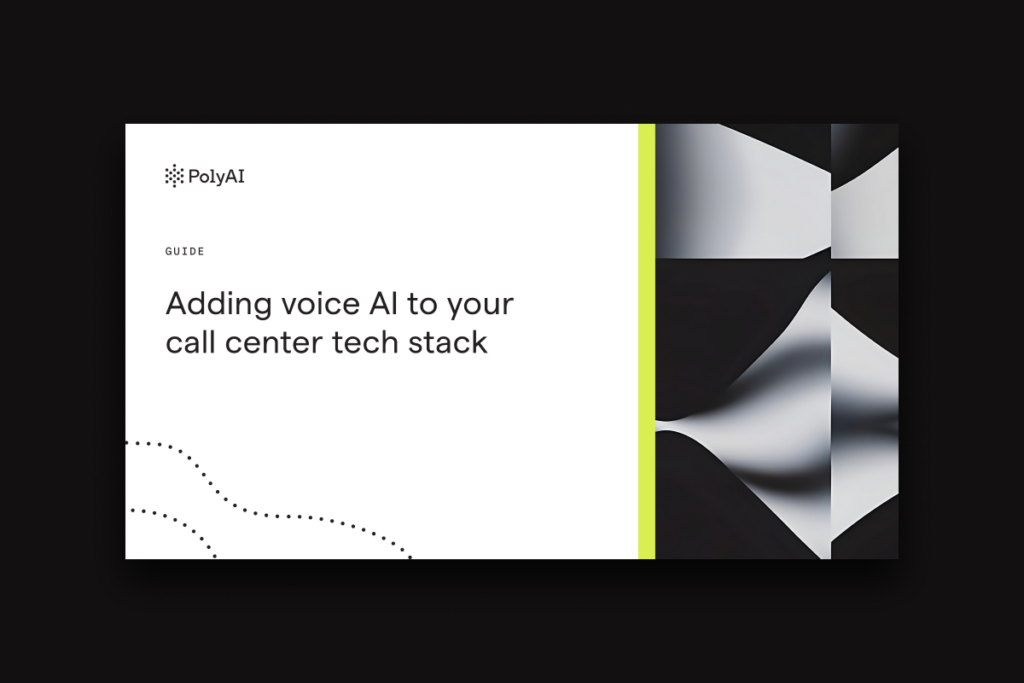Table of Contents
Healthcare is built on human connection, but delivering empathetic, responsive care at scale can be an operational challenge. Legacy infrastructure, rigid systems, and strict regulations present major challenges to scaling high-touch support.
At the same time, patient expectations are rising. Today’s patients are also today’s consumers. They’re used to a seamless, high-touch experience in retail, banking, and travel, and they expect the same from their healthcare providers.
In our recent customer service trends report, 75% of CX and contact center leaders said customers want both immediate responses and more knowledgeable guidance from support teams. But delivering that kind of experience is hard without the right tools.
That’s why more healthcare organizations are turning to voice AI to handle high call volumes and meet rising expectations with faster, more personalized interactions across key patient touchpoints.
When it comes to choosing a provider, 86% say that a good patient experience is their top priority.
Key areas where voice AI is transforming healthcare patient services
Here are 10 ways healthcare organizations are already using voice AI to improve the patient experience. The following are some of the most impactful use cases to begin your organization’s voice AI journey.
1. Self-service FAQs
Not every patient request needs a conversation with a live agent. Many patients are simply looking for quick answers about clinic hours, test results, prescription refills, or how to prepare for a procedure. But too often, the self-service tools designed to help them fall short.
Healthcare organizations have invested heavily in portals and online help centers—but patients still pick up the phone. Sometimes, it’s because the interface is clunky. Other times, the information is outdated or just too hard to find. In our research, 86% of Gen-Z and younger Millennials said they prefer the voice channel for customer service. And 71% are open to using intelligent voice assistants—as long as they can get the job done.
As a result, agents spend too much time handling the same routine questions. This time could be better spent hyper-focusing on patients who need more support and guidance.
Voice AI helps close this gap.
By answering common questions through natural conversation, AI agents give patients the clarity they need without long wait times or transfers. Features like SMS follow-ups for test results add an extra layer of convenience, helping patients feel informed and in control.
Howard Brown Health improved its central scheduling and call center operations with PolyAI.
Streamlining key touchpoints has enhanced the patient experience and made operations more efficient.
Hear more about their experience with voice AI from Howard Brown Health’s Chief Information Officer, Lauren Sullivan.
2. Smart scheduling
Scheduling may seem routine, but as one of the highest-volume call types healthcare organizations manage, these calls quickly lead to long queues, delayed callbacks, and limited capacity for staff to keep up.
And patients feel this impact. Whether they’re booking, rescheduling, or canceling an appointment, long wait times can make the process frustrating. In many cases, they may not call at all, adding to the growing cost of missed appointments. In the U.S. healthcare system, no-shows cost an estimated $150 billion annually and represent lost time, lost revenue, and a missed opportunity to deliver care.
This is an area where Voice AI can provide relief. By enabling patients to schedule, cancel, or reschedule appointments on their own time, AI agents reduce call volume and free up staff. Automated reminders can also reduce no-shows, improving both patient outcomes and operational efficiency.
3. Intelligent call routing
Not every patient call is the same. Some are quick and simple, while others are complex, emotional, and deeply personal. But legacy systems like touch-tone menus or keyword-driven IVRs don’t leave much room for nuance. Reducing a patient’s need for a number or single word often leads to frustration, not resolution.
It also strains human agents, who spend valuable time on routine tasks instead of supporting patients with more sensitive needs and misses the opportunity for them to sharpen their skills to handle more complex calls in the future.
Voice AI changes that. By enabling natural, two-way conversations, AI agents give patients the space to explain what they need in their own words. They can ask follow-up questions, clarify details, and get routed to the right department or provider without the friction of outdated menus.
This kind of intelligent routing improves efficiency. It also helps patients feel heard, especially when they’re navigating stressful, uncertain, or emotional moments.
4. Manage billings and payments
Billing can be one of the most common sources of frustration in healthcare. Confusing statements and unclear processes only add stress to what may already be a difficult time for patients.
Voice AI can ease that burden. Patients can call in and get help with bills, update insurance information, ask questions about Medicaid or Medicare, and explore payment plans without waiting for a live agent. AI agents can quickly pull up relevant account details—like recent payments or insurance status—to respond with speed and accuracy. By handling routine billing inquiries with clarity and consistency, they help patients feel more in control and reduce the load on billing teams.
Transforming the patient experience with conversational AI.
Read the guide5. Prescription support
Prescription-related calls take up more pharmacy time than most people realize. Patients want to know if their medication is ready, whether it was approved by insurance, or how to request a refill. These aren’t clinical questions, but they still land on the pharmacist’s desk.
Pharmacy teams spend hours each day handling these routine updates. And when delays happen it creates even more back-and-forth between patients, providers, and payers. This time would be better spent on clinical conversations, such as counseling patients on new medications or managing complex treatment plans.
Beyond the agent level, voice AI helps reduce administrative burden. AI agents can check prescription status, confirm refill eligibility, and send proactive notifications when medications are ready for pickup. They can also handle the first steps of insurance follow-up or route patients to the right channel for resolution. By offloading these high-volume, low-complexity calls, voice AI gives pharmacy staff more space to focus on what really matters: safe, personalized care.
How Howard Brown Health provides personalized patient experiences with PolyAI
Read the case study6. Non-emergency medical transport scheduling
Access to reliable non-emergency medical transport (NEMT) is often the difference between receiving timely care and going without.
Like appointment scheduling, booking transport isn’t always straightforward using outdated systems. Long wait times and manual scheduling make it difficult to arrange transport, which can mean missed routine check-ups, physical therapy, or post-surgical follow-up.
Voice AI simplifies the process. Patients can schedule, reschedule, or cancel rides using natural language without the need to wait on hold or navigate confusing menus. It’s a faster, more accessible way to coordinate care logistics, especially for patients who need support the most.
7. Record requests
Requesting medical records is often straightforward, but it still takes up valuable agent time. Whether patients need documentation for another provider, personal use, or insurance purposes, they often end up waiting on hold or bouncing between departments to make it happen.
Voice AI makes the process more efficient. It can quickly pull up the right documents and handle routine requests without human intervention. That frees up agents to focus on more complex issues and lets them get to the heart of the matter faster.
8. Automated triage
When patients call with symptoms or health concerns, they need quick answers and clear guidance. But many phone systems still use basic menus that don’t adapt to what the patient is actually experiencing. That can slow down care and leave people unsure on what to do next.
Instead of using rigid menus, AI agents can have natural conversations to understand a patient’s symptoms and ask the right follow-up questions. Based on the answers, the AI can specify the exact steps to take or accurately hand them off to the right team for urgent attention to reduce the number of calls that are routed to the wrong department.
Voice AI can assist with triage by identifying symptoms, providing accurate information and guidance to patients, and routing calls to the appropriate provider as needed.
Voice AI in health insurance
Explore real-world examples of how voice AI can handle tasks like claims processing, policy renewals, and multilingual support.
Read the guide9. Turning patient conversations into insights
Understanding how patients feel takes more than a post-call survey or a checkbox. Traditional methods often miss the details of how patients actually experience their care, what frustrates them, and what makes them feel supported.
But this feedback is essential. It should shape how you support patients, how you train staff, and how every department works to improve the overall patient experience.
Voice AI helps close that gap. By turning real conversations into structured insights, AI agents can uncover pain points in the patient journey, flag recurring issues, and highlight opportunities to improve service delivery.
10. Multilingual patient support
Language shouldn’t be a barrier to care, but it still is in many health systems. Patients with limited English proficiency often face long wait times for interpreters or rely on family members to help navigate sensitive medical conversations.
Voice AI can help close that gap. AI agents can speak multiple languages fluently and switch between them based on patient preference. Whether someone needs help scheduling an appointment, requesting records, or understanding a bill, they can get support in their native language without delay.
Embracing voice AI for a better healthcare experience
As the healthcare space continues to become increasingly more complicated, voice AI offers a powerful solution to enhance the patient experience and streamline operations.
From self-service FAQs and smart scheduling to multilingual support and automated triage, voice AI can help tackle the most common challenges in healthcare today. By automating routine tasks and empowering patients with personalized, accessible services, healthcare providers can focus on delivering high-quality, compassionate care. The adoption of voice AI not only improves operational efficiency but also drives better patient outcomes, making it an essential tool for the future of healthcare.
Speak to our team today about how PolyAI can help you simplify patient access over the phone. Take appointments, answer FAQs, and route phone calls with a conversational AI agent.




